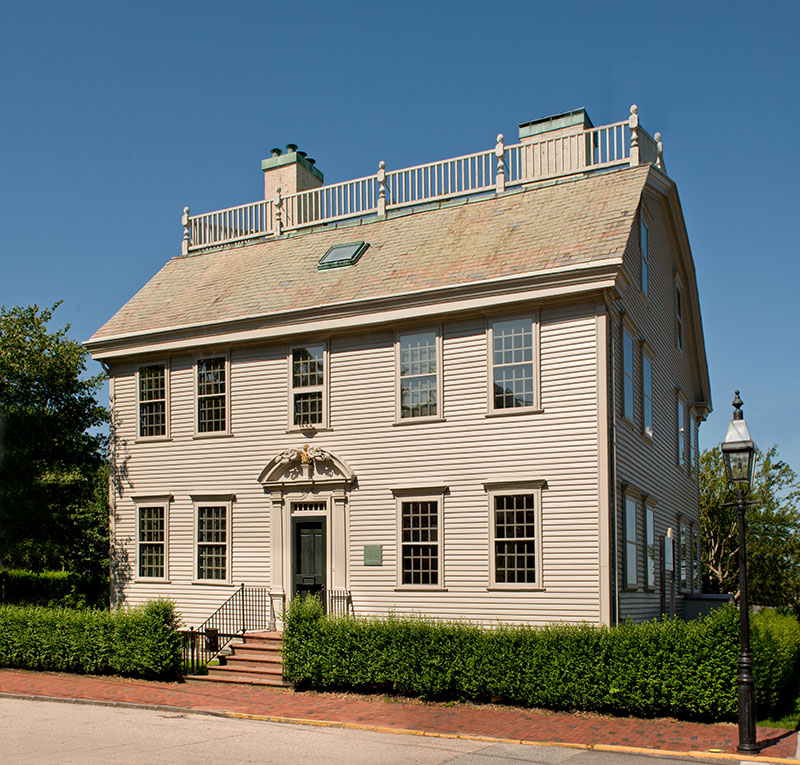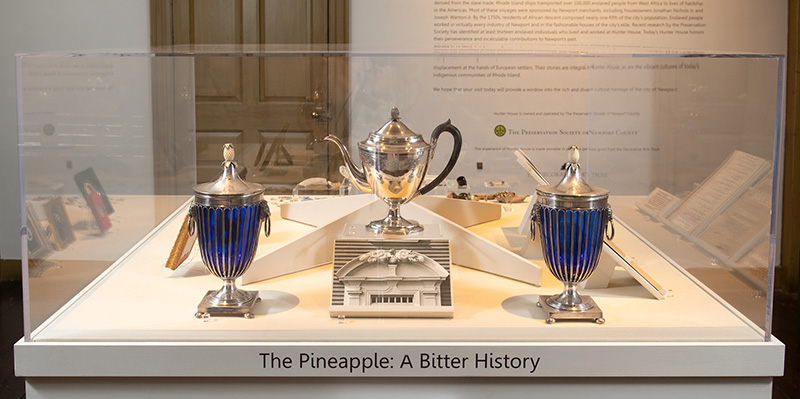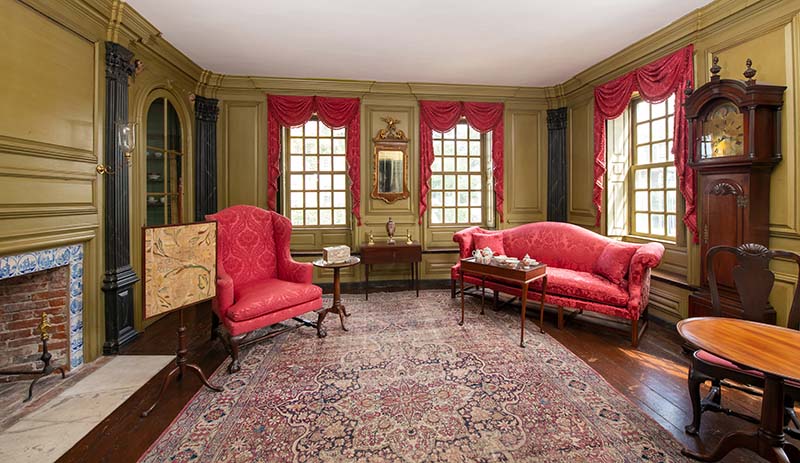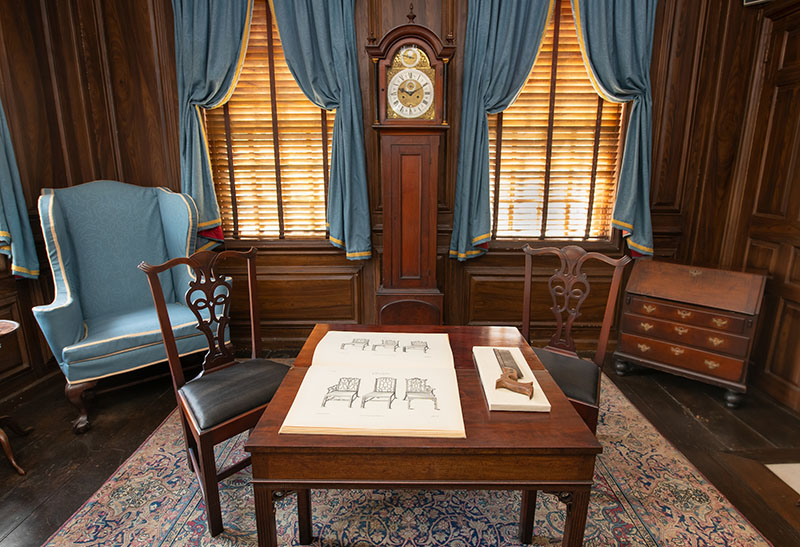A New Vision for Newport’s Hunter House
by Leslie B. Jones, Nicole J. Williams, and MaryKate Smolenski
In August, The Preservation Society of Newport County reopened its landmark colonial property Hunter House (figure 1) with a new guide-led tour that highlights the experiences of the home’s many occupants, including generations of prosperous merchants and enslaved and free people of African descent. The new visitor experience was made possible through the generosity of the Decorative Arts Trust. A Dean F. Failey Grant supported the conversion of two period rooms into gallery spaces to facilitate close looking and research conducted by fellows MaryKate Smolenski and Catherine Doucette.
The plan to reinterpret Hunter House was guided by the vision of legendary connoisseur and conservationist Ralph E. Carpenter (1909–2009). After Hunter House was acquired by the Preservation Society (then the 54 Washington Street Company) in 1945, Carpenter led the effort to furnish the property with the aim of opening a house museum that formed “an active functioning part of community life, constantly interpreting as many sides of the past as possible in terms the people of today can understand.”1 Preservation Society staff and fellows recognized the need to expand the narratives told at Hunter House to center important aspects of Newport’s past left out from previous iterations of the tour, such as the major role the city played in histories of colonization and the transatlantic slave trade. Project participants especially hoped to learn more about the lives of individuals enslaved at Hunter House.
MaryKate and Catherine spent their initial fellowship year researching the house, its occupants, and its collections at the Preservation Society and in local archives. They found that Jonathan Nichols Jr. (1712–1756) and Joseph Wanton Jr. (1730–1780), both wealthy merchants who owned the house in the 18th century, enslaved men and women on the property. Altogether, the team identified 13 enslaved individuals who lived and worked at Hunter House. They also discovered that Wanton’s vast fortune derived from the slave trade.
During her second fellowship year, MaryKate collaborated with Preservation Society staff to translate this research into a tour script and reinstallation scheme. The new text recognizes the significance of enslaved labor to the celebrated craft industries of Newport and to the city’s maritime wealth, emphasizing the work of enslaved people at Hunter House that made Nichols’s and Wanton’s lavish lifestyles possible. Importantly, the text also celebrates the perseverance and resistance of Newport’s enslaved residents. For example, visitors are introduced to James, an enslaved man who ran away from Hunter House in 1767. That year, Wanton placed a runaway advertisement in The Newport Mercury offering a reward for James’s return. James was evidently courageous, resourceful, and determined to live free.
The advertisement is one of a selection of artifacts displayed in the new Orientation Gallery, formerly interpreted as a keeping room. Beginning in 2021, extensive work was completed to clear the room; install custom overhead lighting; and design casework, wall texts, and seating to offer a comfortable space for guests to congregate prior to the start of their tour. A large center case contains thematic groupings of objects that tell the complex history of the house (figure 2). Here visitors can examine a historic photograph of the house’s pineapple pediment alongside a silver coffee pot and a pair of covered baskets adorned with pineapple finials (figure 4). The display discusses the tropical fruit as a product of colonization and slavery as well as a symbol of wealth and hospitality in colonial Newport. For the Preservation Society, which long ago adopted the pineapple as part of its logo, this analysis represents a paradigm shift.
A second gallery-style installation was created in a space traditionally furnished as a dining room. This new installation focuses on foodways in 18th-century Newport and allows closer looking at objects ranging from Chinese export porcelain to English glasswork and Newport pewter and silver.
Additional spaces in Hunter House remain period rooms, such as the northeast parlor with its elaborate decorative paneling (figure 3) and
the southeast sitting room (figure 4). The latter room is now devoted to the theme of artistic exchange among diverse makers in the colonial era, including Quaker cabinetmakers in 18th-century Newport, African-heritage Newporters, European cabinetmakers, and Chinese artisans. The new visitor experience embraces a dynamic, chronological approach that explores additional ownership periods and tracks the property’s transformations over three centuries. Visitors can now learn about the important period of French occupation in 1780–81, when the house served as the headquarters for the French Navy, and the Federal and Antebellum eras when the house belonged to the Hunter family. The tour addresses subsequent reinventions of the structure as a boarding house, convalescent home, and convent housing Catholic nuns, reflecting the growing Irish Catholic community of early-20th-century Newport.
The tour ends in an upstairs bedchamber, where the Preservation Society’s efforts to save, restore, and open the house as a museum are discussed in the context of the Colonial Revival Movement. As guides tell visitors, the era’s mood was nostalgic for a lost “golden age” and did not acknowledge the more difficult aspects of Newport’s past. The new tour corrects romanticized presentations of colonial Newport and turns Hunter House into a welcoming space for visitors of many backgrounds.
The Preservation Society is grateful to the Decorative Arts Trust for supporting this important work. We invite you to visit the Trust’s website to watch a virtual tour of Hunter House.
- Louis C. Jones, “A Look at Historic Preservation,” The Magazine Antiques 70, no. 1 (July 1956): 38. Epigraph in Ralph E. Carpenter, Jr., “Schemes for an Exhibition House,” The Magazine Antiques 70, no. 1 (July 1956): 55.
Leslie B. Jones is the Director of Museum Affairs and Chief Curator for The Preservation Society of Newport County.
Nicole J. Williams is the Curator of Collections for The Preservation Society of Newport County.
MaryKate Smolenski is a PhD Student at Boston University and the 2020–2022 Research Fellow for The Preservation Society of Newport County.
A print version of this article was published in The Magazine of the Decorative Arts Trust, one of our most popular member benefits. Join today!




